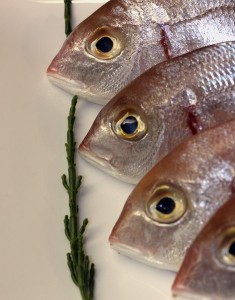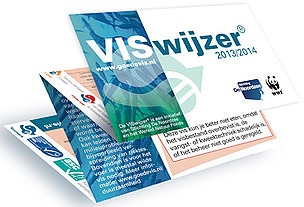Fish
 Many fish is threatened with extinction. Catching fish might take much energy depending on the trapping technique. In addition, cultivation, transportation and cooling of fish takes energy. If you want to know which fish is caught with what technique you can look into the VISwijzer (Seafood Guide). The VISwijzer is prepared by the North Sea Foundation, GoodFishFoundation and WWF. North Sea Foundation is an independent nature and environmental organization, which is committed to a clean and beautiful North Sea.
Many fish is threatened with extinction. Catching fish might take much energy depending on the trapping technique. In addition, cultivation, transportation and cooling of fish takes energy. If you want to know which fish is caught with what technique you can look into the VISwijzer (Seafood Guide). The VISwijzer is prepared by the North Sea Foundation, GoodFishFoundation and WWF. North Sea Foundation is an independent nature and environmental organization, which is committed to a clean and beautiful North Sea.
What does the VISwijzer keep in mind?
Each species is assessed separately. The assessment method consists of criteria for wild caught fish and criteria for farmed fish.
|
Criteria for wild caught fish: Criteria voor farmed fish: |
www.goedevis.nl, Stichting De Noordzee, Utrecht, 2011
In the list below the fishes are summarized which have been approved by Stichting De Noordzee as Prima keuze (=Great Choice) [1] .
- Mullet WaddenSea, Fishing-method: Gillnet fishery
- Cod Baltic, Fishing-method: Gillnet fishery, Lines
- Coalfish NO part atl. ocean, Fishing-method: Lines
- Lobster Oosterschelde, Fishing-method: Fish traps
- Schelvis Iceland, Fishing-method: bottom fishing, but also with lines, at AlbertHeijn sure[2]
- Sea bass (the Netherlands, NortSea), Fishing-method: LineFishing, but also bodemvisserij
- Swordvis (NW Atl. Ocean), handline or harpoon
- Claresse or Meerval (the Netherlands), method: Farmed, recirculation systems
- Forel Biologisch (the Netherlands), Belgium, method: Farmed, Doorstroomsystemen, Closed systems, Kooien in zee, Kooien in rivier
- Mossel (the Netherlands), method: Farmed, hangingculture, but also bottomtrawl
- Oester (the Netherlands), method: BottomFarmed
- Tarbot, Farmed (the Netherlands), method: Farmed, recirculation systems
- Tilapia (the Netherlands), Belgium, method: Farmed,recirculation systems
- Victoria Perch (Tanzania), Naturland
- Crayfish (China), Fish traps
- Tuna Albacore (Pacific Ocean), Lines
- Tuna Skipjack (East Atl., Pacific and Ind. Ocean.), Lines
Note: The method of fishing and/or specific origin of a fish leads to the label Prima Keuze (=Great Choice). So pay attention to that in the store. E.g. Haddock caught with lines is fine, but with bottom fishing again second choice. It is important to check the VISwijzer(=Fishpointer) on a yearly base, since there are new developments which may be an impact on the different fish.
M SC stands for Marine Stewardship Council and is similar to FSC-certified wood (well managed forests). Who buys a fish or fish product with the MSC label knows that this fish is caught responsibly and that nature is spared. The label is recognizable by the blue logo. The customer can assume that the fish actually comes from fishermen who fish in a sustainable manner; there is no overfishing, damage to the soil or too much by-catch. MSC fish is in the first column of the VISwijzer.
SC stands for Marine Stewardship Council and is similar to FSC-certified wood (well managed forests). Who buys a fish or fish product with the MSC label knows that this fish is caught responsibly and that nature is spared. The label is recognizable by the blue logo. The customer can assume that the fish actually comes from fishermen who fish in a sustainable manner; there is no overfishing, damage to the soil or too much by-catch. MSC fish is in the first column of the VISwijzer.
ASC In 2012 Aquaculture Stewardship Council (ASC) was founded by WWF and Initiatief Duurzame Handel (IDH). ASC is an independent organization which certifies sustainable farmed fish. [5]
What is the environmental impact of the various species of fish?
The VISwijzer does not include information about a number of things. About the VISwijzer: “The energy consumption in the fishing phase is not taken into account. The chain links, after landing ashore (such as transport, processing and packaging) are also not included in the VISwijzer “ [6].
By Blonk Milieuadvies two reports were made in which several popular fish species on their environmental impacts are compared [7] . Blonk takes into account the energy use in the chain of fish:
- Energy content of fossil fuels required for capture, cooling, processing, and transport of fish
- Energy use for the production of electricity and fossil fuels
- Energy use for the production of packaging
| Type |
Energy use MJ/kg |
|
Mackerel[8] |
<=Haring |
|
Herringfilet from North-Europe |
14-20 |
|
Pangasiusfilet farmed in Vietnam |
28-31 |
|
Coalfishfilet from Alaska |
35-36 |
|
Mussels [2] |
>coalfish and <farmed salmon |
|
Atlantic farmed_salmonfilet (Scotland, Norway) |
38 |
|
Codfilet from waters round Iceland and Scotland |
61-105 |
|
Shrimp[2] |
>=cod |
Table Blonk milieuadvies, Environmental effects of fish, may 2009
Wild caught fish (not-farmed): To a large extent the energy load on the environment is determined by the method of capture. Methods that drag nets across the bottom (bottom fishing, trawling), cause a lot of soil damage and require a lot of fuel. Fish that do not live on the bottom, called pelagic species, do not have to be caught with bottom-nets and require consequently less energy (ring nets / purse seine, line fishing, gillnet fishery).
Because not all fish are included in the analysis of Blonk, the author made an assumption about the environmental impact (based on the method of capture). It is assumed that pelagic species from N-Europe consume as much energy as the herring fishing from N-Europe with purse seines. In table 2 in the Appendix these assumptions have been incorporated.
Farmed fish: Regarding “farmed fish” only figures are known from Pangasius (farmed, Vietnam) and Salmon (farmed, Norway). Panga is just above the value of chicken breast, Dutch farmed fish takes probably less transport and cooling energy. You might therefore conclude that Dutch farmed fish are below or around the acceptable level of chicken breast.
Conclusion / recommended fishes:
- Herring (MSC), Codfish (MSC) and Sea Bass (LineFishing), Mullet (Gill net fishery) from the North-European waters take less indirect energy than chickenbreast[9] , moreover, they are responsible caught and is no overfishing, damage to the soil or by-catch.
- Claresse/Catfish, Tilapia and Turbot(Farmed), all Dutch farmed fishes, they are probably under or around the levels of chickenbreast.[10]
- There is no comparable data available at the author about the total energy use of fishes produced/catched outside Europe. The VISwijzer indicates the following fishes as “Great Choice”: Swordfish (NW Atl. Oceaan), Victoria Perch (Tanzania), Crayfish (China), Tuna Albacore (Pacific), Tuna Skipjack (East atl., Pacific and Ind. Ocean.) and also the fishing-methods do not lead to above average energy use.
[1] www.noordzee.nl, september 2011
[2] www.ah.nl/artikel?trg=albertheijn/article.waarden.duurzaamheid.vissoort, zie ook http://www.c1000.nl/over-c1000/duurzame-vis
[3] Sole has performed poorly in the North Sea, for that reason it is not considered further.
[4] http://www.wnf.nl
[5] http://www.wnf.nl
[6] Milieueffecten van enkele populaire vissoorten, Blonk Milieuadvies, Mei 2009, H.Blonk, B. Luske, A. Kool
[7] expired
[8] Milieueffecten van Nederlandse consumptie van eiwitrijke producten, Blonk Milieuadvies, oktober 2008, H.Blonk, B. Luske, A. Kool
[9] Translated to the energy for herring by Gerbens-Leenes, P.W. GroenKookboek. Groningen: RuG, 2000 it is 53,3 MJ/kg
[10] Translated to the energy for chicken by Gerbens-Leenes it is roughly 86 MJ/kg

